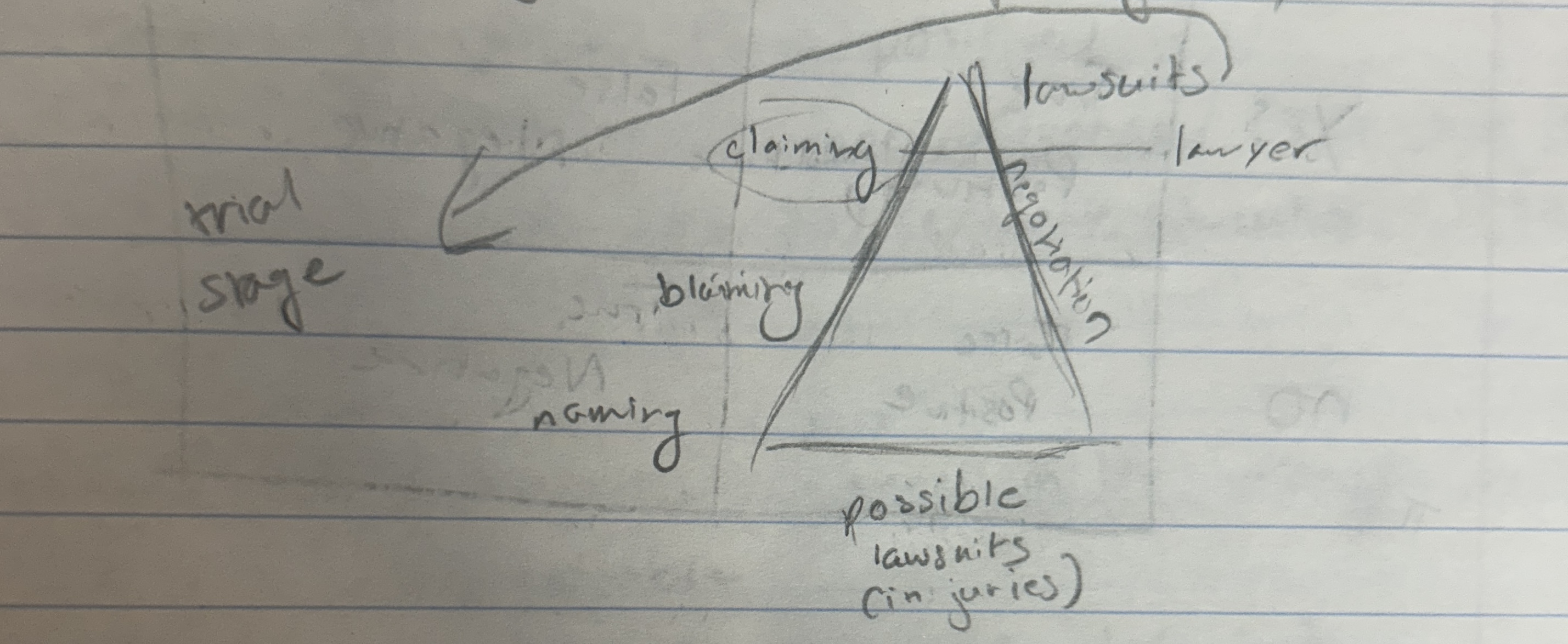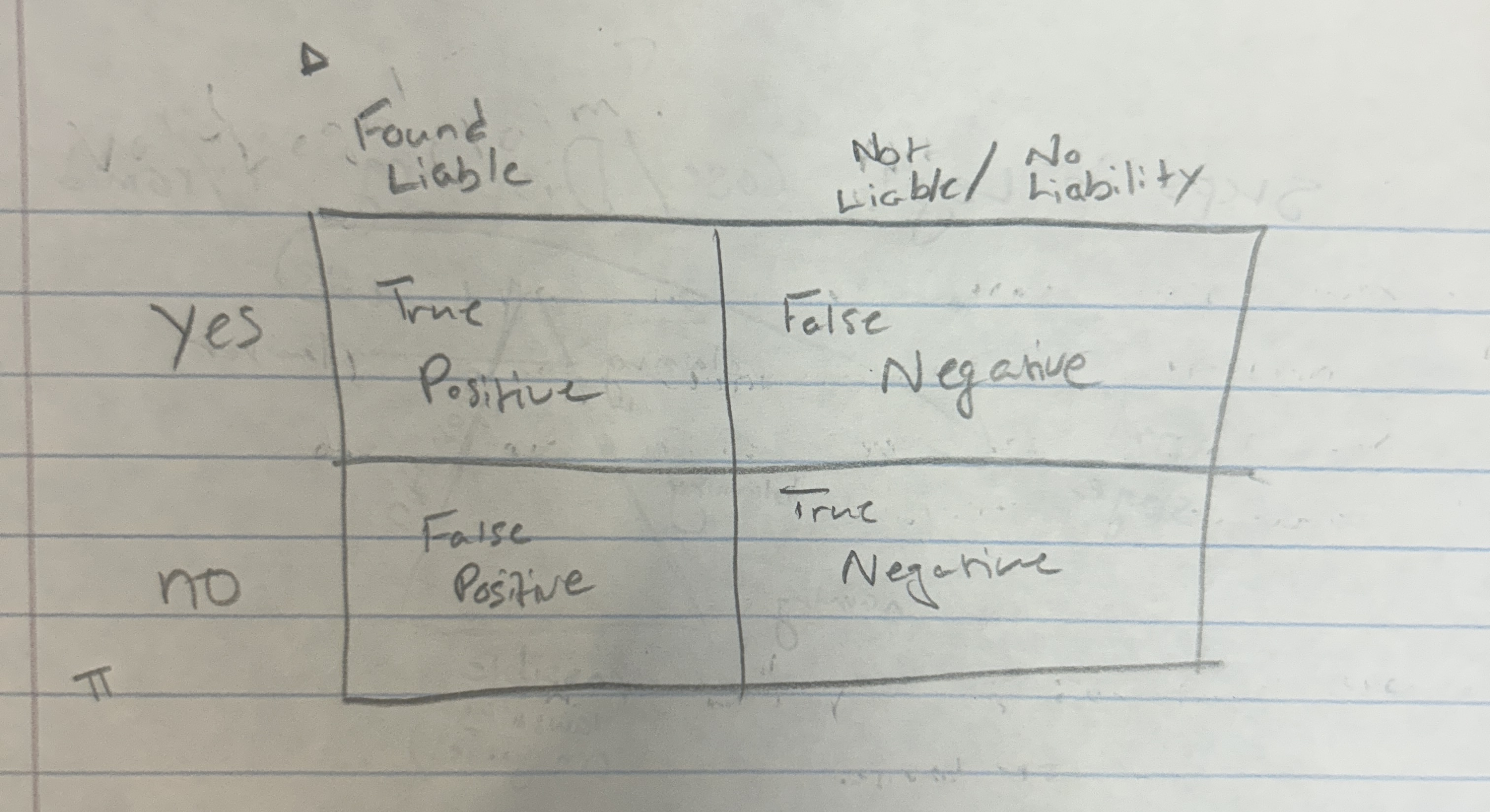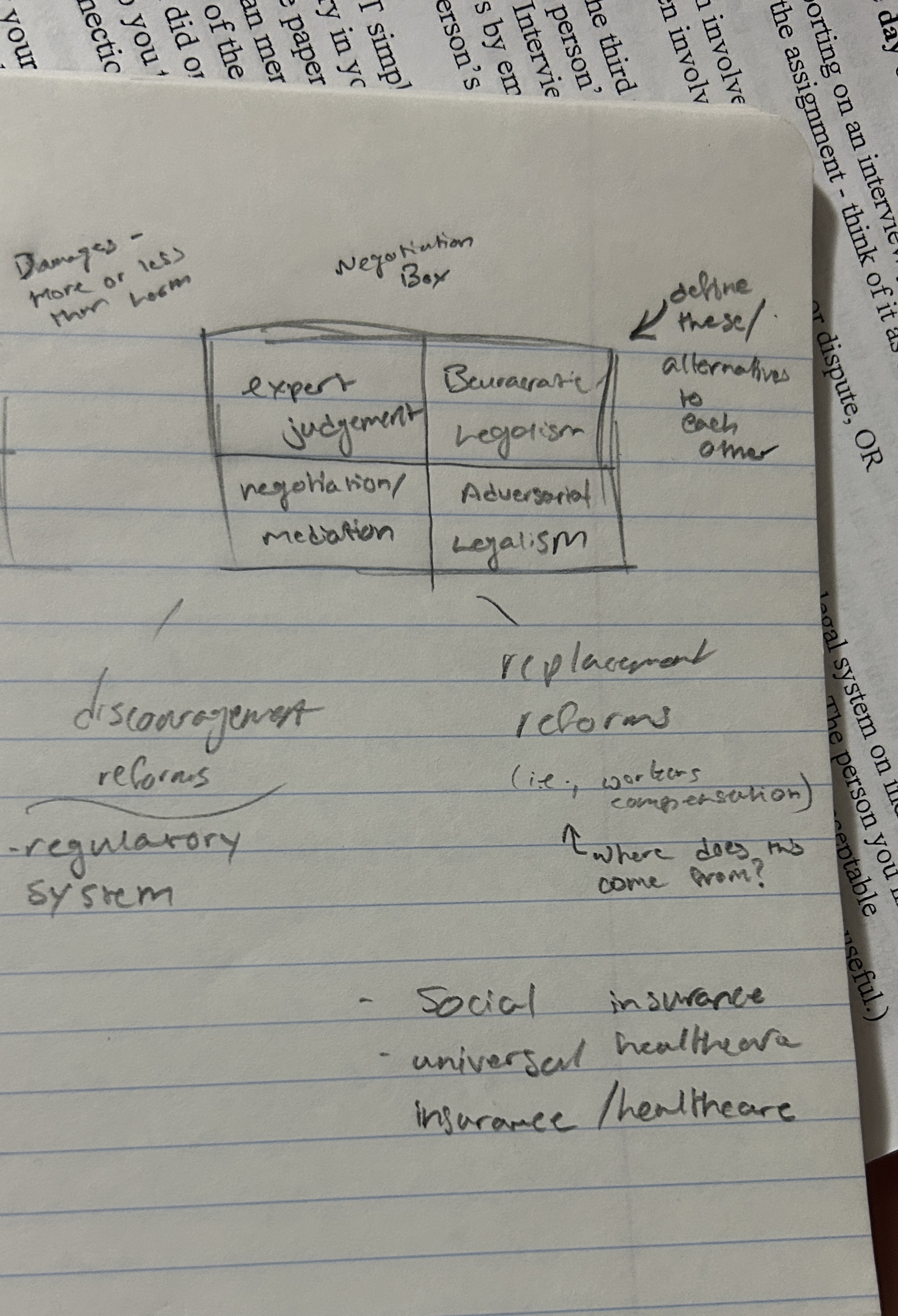US Legal System Exam #2
1/60
There's no tags or description
Looks like no tags are added yet.
Name | Mastery | Learn | Test | Matching | Spaced |
|---|
No study sessions yet.
61 Terms
Civil Justice is who against who?
Chamber of Commerce vs Trial Lawyers
Plaintiff Lawyers and companies are on the same side or the opposing?
opposing side
What do lawyers and companies try to do?
both try to influence who is put into government (judges)
Torts
are personal injury cases/ harm
Where does Tort Law come from
Judges
Wind fall payment
got more money then you deserve
Punitive reward
or "punitive damages" are monetary awards, awarded in addition to compensatory damages, that are intended to punish a defendant for egregious or malicious conduct and deter similar behavior in the future.
3 things to understand
understand how civil justice works
reforms and problems with civil justice
what are the alternatives
What is civil justice
anything that is not criminal
it attempts to determine whether an offender or a third party is liable for the injuries sustained as a result of the crime.
What makes it Criminal Law
brought by the government (state vs. ) (could also happen in civil law but less common there)
government prosecution (could also happen in civil law but less common there)
always has a defendant (could also happen in civil law but less common there)
can send to jail (cannot do this in civil)
Who is civil justice between?
individuals vs individuals; individuals vs corporations; corporations vs corporations
Civil Law covers what type of cases
personal disputes (property, real estate, custody, divorce, copy write, immigration, traffic violation, contract law, etc)
Contingency Fees
(only done for civil law)
a sum of money that a lawyer receives as a fee only if the case is won.
Alternatives to Civil law
workers compensations
Examples of Tort cases
car accident, battery, assault, libel, product, etc
Who pays for the lawyer?
English rule loser pays, American rule everyone pays their own lawyer
Is there adversarial legalism within civil justice
Yes (ex. Alabama Prison Reform)
What are the two problems with Civil Justice?
Time and Money
Disputing Pyramid

If your insurance drops you after you’ve been injured and they are suppose to pay you can…
sue for breach of contract
Steps in Legal Case (6 steps)
File a complaint (the plaintiff files it)
legal cause of action
served on defendant
Defendant files an answer (failure to submit a defense means you lose automatically)
Motion to dismiss (must prove its work being in court/need to show proof)
pre-trial discovery → interrogations, request for documents, affidavits, depositions
summary judgement
Brack Duckler example
Gilmore v. Columbia Falls Aluminum Company
The corporate owner of Atlantic Richfield Company (ARCO), sold hthe company to Brack Ducker for $1, plus $3 million for unsold inventory.
As apart of this deal, the parties agreed to give the workers 50% of any future annual profit.
Later on Ducker cut this deal and brought it down to 15% with promise of 50% in the future
The workers agreed
They never went back to the 50% and eventually sued and won
This is an example of a True Positive Case
Its a good example of American Adversarial Legalism and the strength of class action lawsuits.
Compensatory damages— basically the opposite of punitive damages with the aim to reimburse the plaintiff for their losses (medical bills, property damage, etc.)
where do you file complaint (Hint: this can show decentralization of government)
look for the courthouse/judge where you’d have the best bet to win
In order for the defense to win you need to prove …
without a shadow of doubt
Valid Legal Claim Chart
think of the results like a covid test
false positive = wrongful conviction
false negative = the guilty get to walk free

To win a case which side is more…
believable
What does the symbol pie stand for
plantiff
what does the symbol of a triangle stand for
defendant
What are the Key purposes of a valid legal claim
compensation
deterrence (promote safety)
Duty of Care
how much are we meant to value other safety and how much is it our responsibility
prove this was breached or negligence
injury (must have a proven injury)
causation (the connection between injury and negligence)
damages (how much the injury is worth)
compensating damages
financial
pain and suffering
punitive damages (must prove more than negligence)
negligence
when duty of care is breached
Johnson v. Johnson
(under influence) (extortive litigation)
After Seward Johnson died his will stated that the majority of his estate would go to his third wife
his will left nothing to his 6 kids
Th kids challenged the validity of the will and since the wife didn’t have access to the funds yet she lost
Basia (the wife) agreed to settle and gave about $40 million to the Johnson children and paid their legal fees
Dixie Flag case (pg 136)
(extortive education) (false positive) - Kegan example
vendectan (pg 133-134)
What does it mean to settle
it doesn’t mean that you are admitting fault (false positive)
How predictable are jury verdicts?
extremely unpredictable
Class action
multiple plaintiffs sue same defendant
Common law
law passed down; newer judges follow older judges verdict (common sense)
in order to make a better judgement with the common law development of tort law, you’d need what 4 factors
case facts
social background facts
rule → duty of care (to whom0
injury
damages
values
The 4 factors harmonize for reasoning
Case decision 2 factors
Facts (used for later cases)
rule
Same or Different Rule (Reason in Law (pg 40))
Cherry Tree Case (pg 63 reason in law)
Pit and the Alley
Who is responsible for what injury
Diving Board Case
Barge Case
Tarasoff Case
The psychiatrist knew that Tatiana was in danger and called the police but never informed her nor her family of her danger
Tatiana was murdered by her brothers roommate, who was known to be planning to hurt her
The staff could have easily informed her however they did not and Tatiana’s parents sued the school
Reasoning by example played a major role in this case.
the parents argued that the school had duty of care to protect their daughter
important to consider that a “defendant owes a duty of care to all persons who are foreseeable endangered by his conduct with respect to all risks which make the conduct unreasonably dangerous.”
Saldono Case
Aug 1977: In Happy Jack’s Saloon, Darrell Soldano was threatened. A patron ran into a nearby Circle Inn to ask the bartender to call 911, but they refused to call or even to allow the patron to call. The confrontation escalated and resulted in Soldano being shot dead. A lawsuit sought damages for Soldano’s son from the Circle Inn, arguing that if the bartender called 911, Soldano wouldn’t have been shot. The Circle Inn argued that it was not the bartender’s responsibility to call 911. Because the law on the situation was unclear, judges had to decide based on the relationship between Soldano and the bartender
Decided according to California Common law, which requires people to treat strangers with care expected of a “reasonable and prudent person”
Background facts: the rising crime problems and the significance of telephones for stopping crimes
Negotiation Box

McDonald’s Coffee Case
Stella Liebeck was burned by McDonald coffee due to its extreme heat.
She was injured so badly and needed skin graph
Her family sent McDonalds a letter asking for money to cover her medical bills. They offered $800 for $10,000 worth of damages.
McDonalds had over 700 previous complaints about hot beverages
Jury believed 20% was Stella’s fault and 80% was McDonalds
Leibeck won $160,000 from the case and 2.7 million in punitive damages
Judges reduced the punitive damages to $480,000
The media poorly represented the case and vilified Liebeck
Colin Nebraska Case
caps on damages
This was a case of malpractice
Colin suffered severe brain damage from lack of oxygen
the doctor had been sued twice before for malpractice
the family needed for $6 million to take care of Colin for the rest of his life
won $5.6 million but due to caps on damages it was reduced to $1.4 million after the case
The judge said it was unconstitutional to caps so the Doctor appealed and the Nebraska Supreme Court said it was constitutional, reducing the money that Colin’s family would be rewarded.
Caps on Damages
a form tort reform that limits how much money you can earn from a trial.
Oliver Diaz Case
interest groups worked against Diaz because he was deemed not business enough
The US Chambers of Commerce is not apart of the government and is rather made up of large businesses
The Chamber of Commerce puts money into campaigns they agree with
the election between Diaz and the other candidate was a runoff and Diaz had to get a loan
Diaz won the case and then the US Chamber of Commerce work to indict him
Diaz was acquitted from all crimes and re-indicted for tax evasion and then acquitted again
He spent three years of his time off the bench because of the case and his reputation was ruined.
Diaz lost in the 2008 election against the US Chamber of Commerce campaign
What does Civil Court do?
hold those accountable
what is the only place you can bring a large business to judgement/ hold them accountable
the Supreme Court
Tort reform
is to limit the way people can go to court (limit rights)
business support this
who makes up the American Tort Reform Association
tons of businesses
What are the three types of caps on damages?
Punitive, non economic, and economic damages
punitive damages
damages exceeding simple compensation and awarded to punish the defendant.
Non-economic damages
compensation for subjective, non-monetary losses like pain, suffering, emotional distress, and loss of enjoyment of life, distinct from economic damages which are tangible financial losses.
Economic damages
tangible, quantifiable financial losses a person incurs due to an injury or harm, such as medical expenses, lost wages, and property damage.
Mandatory Arbitration
clauses that say you can’t go to court and have to solve disputes through arbitration.